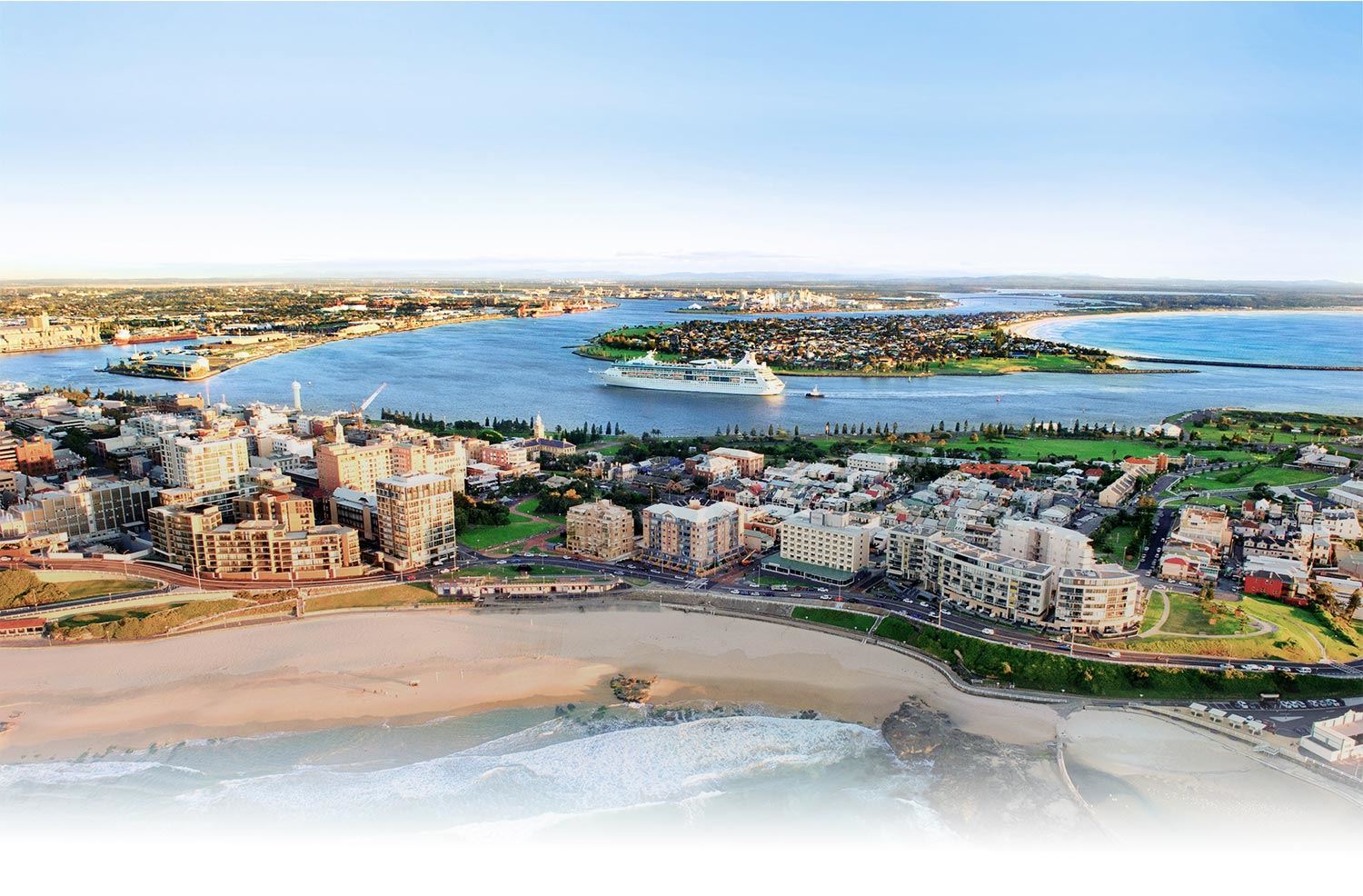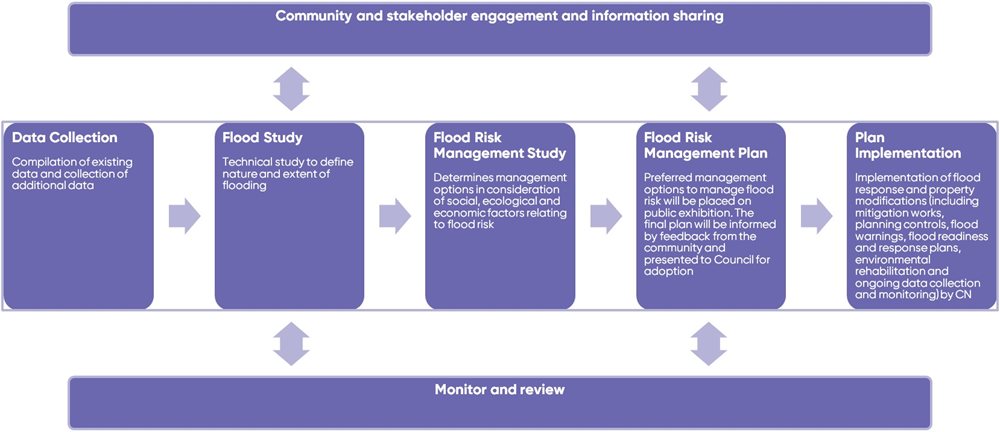
- Living / Environment / Flooding

Flooding affects up to one third of all properties in Newcastle, so it's important to be aware of your flood risk at home, work, school and other places you visit frequently. It can also occur quickly - sometimes there is less than an hour of warning between the beginning of a storm and the onset of flooding.
Be prepared - know what to do before, during and after a flood.
Flood Alert Service
Sign up to our Flood Alert Service to be notified in case of an emergency.
You can register online by completing this form and setting the areas you would like to be notified about. Once registered, you will receive confirmation of your approval to access the service within 24 hours.
Already registered? Sign into the service to amend your registration and receive alerts for other areas of Newcastle.
Terms and conditions apply. For assistance registering, please contact us.
Our role is to investigate and understand flooding risks and to prepare for future floods through land use planning, development controls, flood mitigation works and community education. It is not possible to predict when, where, or how big the next flood will be. However, we can estimate the likelihood of different sized floods and their consequences so we can plan ahead.
We are working on solutions to reduce flood risk across Newcastle with grant assistance from the NSW and federal governments to implement actions adopted in our flood risk management plans.
What to do before a flood:
-
Know where it floods in your neighbourhood by identifying drains and the local waterway
-
Be aware of your transport routes and plan alternatives to avoid flood prone areas
-
Discuss your flood risk with neighbours
-
Use the interactive map to identify your flood risk
-
Sign up for the Flood Alert Service
-
Visit the SES flood website for information on how to prepare for a flood.
-
Keep informed via ABC Radio Newcastle, the Bureau of Meteorology (BOM) website and social media
What to do during a flood:
-
Check the BOM website for updates on flood warnings in your area
-
Stay indoors and listen to ABC Radio Newcastle
-
Make contact with your neighbours and share information
-
Never walk or drive through flood water - learn more
-
If your home is damaged or flooded call the NSW State Emergency Service (SES) on 132 500
-
Take the advice of the SES if an evacuation order is given
The SES is the lead emergency management agency during floods. Our role during a flood is to assist emergency management departments such as the SES, NSW Rural Fire Service and NSW Police.
What to do after a flood:
-
Contact your home insurer if your home is flood damaged
-
Clean up your property and put waste at the kerbside for collection by the City of Newcastle
-
Contact the City of Newcastle if you have trees that are damaged by the event and require lopping
-
Visit the SES website for further information
It’s our job to coordinate repairs to damaged public assets, such as roads, parks, trees and drainage after a flood. We also apply for grant funding when it is made available from the NSW or Federal Government to cover public asset damages.
How to use the interactive map:
- Read the explanation of the flood maps shown and then click close.
- Type your address into the search window at the top left and press enter. Once you have identified your property, a polygon should highlight it.
- Click on your property anywhere in the polygon to read the flood risk.
- A separate window should pop-up explaining the flood risk at your location. You must click through the explanation of flood risk using the arrows at the top of the window.
- Zoom out and in by using the scroll wheel on your mouse and investigate the flood risk in your local area. Is your street at risk of flooding? Is your local park, shops or school at risk of flooding?
- Investigate the flood risk at your work, school or playground by repeating the process above.
Disclaimer: The City of Newcastle (CN) provides this mapping in good faith for flood education purposes. This mapping is not to be used for flood planning purposes relating to development, and applicants should apply for a site specific Flood Information Certificate. Any errors, omissions or anomalies in the information shall not incur any liability to CN whatsoever.
View map in full screen
What the City of Newcastle is doing to reduce flood risk
Newcastle has historically been built on a floodplain, and it is not possible to eliminate the risk of flooding from our suburbs, however, measures can be taken to reduce flood risk to life and property and improve community resilience, as redevelopment takes place. There are no easy solutions and the most effective means of reducing risk is to apply a range of measures, such as community education, planning controls, emergency management, and flood mitigation works, such as onsite detention and drainage improvements.
Improving our understanding of flood behaviour and risk
We are in the process of updating our flood studies across the Newcastle LGA to improve our understanding of flood impacts and risks, in line with the NSW Flood Risk Management Manual (2023) and Australian Rainfall and Runoff (ARR) Guidelines (2019).
On completion of these flood studies, we will update our Flood Risk Management Study and Plan (FRMSP) for the Newcastle LGA, which will detail our management actions to reduce flood risk for our community. When the FRMSP is finalised, we will seek funding from the NSW Department of Planning and Environment, as well as other disaster relief funds, to assist us in implementing the management actions identified.
 |
Prior to completion of the updated flood studies and FRMSP, we remain committed to implementing the recommendations from the adopted Floodplain Risk Management Plans (FRMP) for the Newcastle City Wide and Wallsend Commercial Area.
Prior to completion of the updated flood studies and FRMSP, we remain committed to implementing the recommendations from the adopted Floodplain Risk Management Plans (FRMP) for the Newcastle City Wide and Wallsend Commercial Area.
Specific Implementation Actions
Flash Flood Alert Service
Register online for our flood alert service.
Wallsend Commercial Area FRMP Implementation Study
After the floods in June 2007, City of Newcastle undertook flood studies and made the FRMP to minimise future flooding. The plan recommended $44M of flood management actions, including the substantial widening of the Ironbark Creek channel through the commercial area, and upgrading the Minmi Road bridge to improve the passage of flood water.
The total cost to implement the FRMP was prohibitive and would not easily attract funding. An Implementation Study was then needed to investigate more cost-effective options. These cost-effective solutions included the removal of the Tyrrell and Boscawen Street road bridges, replacing the road bridges with pedestrian bridges, and the modification of the Nelson Street road bridge. After much review, these recommendations were considered too disruptive to traffic and commercial businesses of the town, and as an alternative, the replacement of all three road bridges is being investigated and implemented.
The current progress on implementing flood mitigation measures for Wallsend commercial area is as follows:
- Tyrell Street Bridge was replaced with an upgraded bridge in 2020
- Boscawen Street Bridge construction is expected to commence in 2023
- Nelson Street Bridge is currently in detailed design with construction anticipated to commence in 2024
Morgan-Selwyn Street Floodway
The Morgan–Selwyn Street floodway in Merewether is a high hazard flood precinct. City of Newcastle worked with the Water Research Laboratory (WRL) of the School of Civil and Environmental Engineering at UNSW Australia to assess a Voluntary Purchase (VP) scheme for the Morgan-Selwyn floodway. VP involves the purchasing of private property that is subject to significant flood risk where no other feasible options of physically reducing the flood risk are available.
After significant research, it was found that in a flood event greater than the 10% AEP (one-in-10-year flood), private properties could be significantly damaged and 11 properties would require purchase using public funds to reduce the flood risk to manageable levels. Currently, we don’t have the funds to implement the VP scheme, so we are working on implementing emergency management measures such as the Flash Flood Alert Service, Flood Signage and Flood Education.
Flood Education Campaign
We have adopted City Wide Flood Mapping and prepared an interactive flood map to increase flood risk awareness of residents.
Low Lying Areas - Phase 1 - Sea & Groundwater Monitoring
On 25 July 2017, the elected Council adopted a strategic position paper (the Paper) to protect low-lying areas from future flood risks associated with climate change. The Paper includes a list of actions (phase 1 -6) that are triggered if increments of sea level rise are recorded. Phase 1 was triggered upon adoption of the Paper and requires sea and groundwater level monitoring.
We have worked with the Department of Planning, Industry and Environment (DPIE) to establish a benchmark and methodology for the measurement of mean sea level rise. The Paper has set the benchmark based on mean sea level at the time of its adoption.
City of Newcastle and the DPIE have since investigated the behaviour of sea levels. The DPIE has recommended using the Fort Denison tide gauge in Sydney for the monitoring because it is the longest publicly available record in the southern hemisphere, and the site holds data of the highest accuracy in NSW. There is not reported to be any difference in sea level rise between Sydney and Newcastle.
Our monitoring suggests sea leaves are rising slowly and there is at least 10 to 25 years until Phase 2 is reached. Phase 2 requires installation of improved flood gates and drainage outlets, high powered pumps, and the design of the levee for construction in Phase 3 (0.2m sea level rise).
In relation to groundwater, wells have been installed in March 2018 and a long-term groundwater monitoring program will commence to better understand groundwater behaviour in the study area.
What is a Flood study
A flood study is a detailed investigation into the flood behaviour and flood risks of a catchment. It is a technical undertaking that produces a flood model.
The flood study defines the depth, velocities, and flood hazard in the study area. A flood study also provides a platform for developing information to support flood risk management, emergency management and land-use planning, and to inform consideration of flood risk management measures as part of flood risk management studies and plans.
Current flood studies for the Newcastle LGA are listed below, covering flash flooding, Hunter River flooding and ocean storm surge.
Throsby, Styx and Cottage Creek Catchments
The Flood Study for the Throsby, Styx and Cottage Creek catchments details flooding impacts for the area to the east of the John Hunter Hospital, from Hunter River and Newcastle Harbour in the north, to the coastline to the east, including the CBD and Merewether, and west to Kotara and Mayfield West. The majority of creeks in these catchments have been converted into open channels and drainage networks, and the capacity of these systems is exceeded during moderate and large storm events, causing flooding of some residential and commercial areas.
Links to the adopted Throsby, Styx and Cottage Creek Flood Study (2023)
Ironbark Creek Catchment
The Flood Study investigates flood behaviour for the urban areas upstream of Hexham Swamp where Ironbark Creek drains the suburbs of Elermore Vale and Wallsend. The creek is predominantly a natural channel with associated floodplain of open spaces and sports fields. During rare storm events, these floodplains can spill into urban areas causing overland flow flooding, resulting in significant flood risk for the Wallsend CBD.
Dark Creek Catchment
The upper catchment of Dark Creek includes the bushland behind Jesmond Park and the suburbs of Callaghan and North Lambton. The capacity of the drainage system and open channel is exceeded during large storm events, and flooding of residential areas and the Jesmond commercial area will occur in moderate to large flood events.
Lower Hunter River
A Lower Hunter River Flood Study found that there are parts of the Newcastle Area vulnerable to Hunter River floods including Beresfield, Tarro, Hexham, Shortland and Sandgate. More recent residential development in Fletcher and Maryland fringes Hexham Swamp and has been built above the predicted flood levels of the Hunter River to reduce flood risk.
Newcastle Harbour
The harbour of Newcastle experiences elevated sea levels in East Coast Low events. These factors can combine to cause storm surge up Newcastle Harbour that floods low areas along the foreshore. Suburbs such as Stockton, Carrington, Wickham, Honeysuckle and Kooragang are particularly sensitive to storm surge.
Newcastle West
Redevelopment of infrastructure and private property is happening in flood prone land surrounding Cottage Creek. City of Newcastle has undertaken a detailed study of flood behaviour in the area around Marketown, Wickham Interchange and Honeysuckle to inform how flood risks can be reduced.
Supporting Studies
A number of studies have been completed over the years prior to the preparation of the flood studies. Supporting documents include:
- PBP (1996). Lower Hunter Valley Floodplain Management Study: Assessment of Strategic Options for Community Consultation (DRAFT). Prepared for Port Stephens and the City of Newcastle.
- PBP (1997). Lower Hunter Valley Floodplain Management Study: Volume A - Assessment of Strategic Options for Community Consultation Summary Report (DRAFT). Prepared for Port Stephens and the City of Newcastle.
- PBP (2001). Lower Hunter Valley Floodplain Management Study: Volume B - Planning Implementation Strategy (DRAFT). Prepared for Port Stephens and the City of Newcastle.
- PBP (2001). Lower Hunter Valley Floodplain Management Study: Volume B - Planning Implementation Strategy (DRAFT), Summary Report. Prepared for Port Stephens and the City of Newcastle.
- PBP (2007). Wallsend Floodplain Risk Management Study and Plan. Prepared for the City of Newcastle.
What is a Flood Risk Management Plan?
The Flood Risk Management Study and Plan (FRMSP) builds on the completed flood study to identify and assess potential management approaches to reduce the impact of flooding on the study area. The FRMSP is publicly exhibited to the community prior to adoption by Council. Management options in the FRMSP can include infrastructure upgrades, alerts and emergency responses, community education, development controls, voluntary house raising or voluntary house purchasing.
Adopted flood risk management plans and studies:
It’s our job to manage the safety, risk, and maintenance of the Minmi Road Detention basin.
To comply with the Dams Safety Regulation 2019, we develop an annual Dam Safety Report to share with residents.
Since its construction in 1986, the dam structure has not reached its full capacity. In 2018, the dam was strengthened with minor drainage works and work on its upstream side.
What is flooding
Flooding is when rivers, creeks, or channels are overtopped and spill onto normally dry land. Flooding is a natural event, and there are 3 types of flooding that can affect Newcastle including:
- Flash flooding: intense rainfall over the local catchment leading to runoff that exceeds the capacity of the drainage network, causing flood water to rise quickly and with limited warning. These floods are common for local waterways in Newcastle, such as Throsby, Styx, Cottage, Dark and Ironbark Creeks.
- Hunter River floods: sustained heavy rainfall in the Hunter River catchment causing high river levels that spill out into the low-lying areas of the floodplain, like Hexham, Beresfield and Sandgate.
- Storm surges: Oceanic storms on the coast causing elevated water levels, severe winds and large waves, common in Newcastle Harbour and our low-lying suburbs, such as Stockton, Carrington, Wickham, Maryville and Islington.
While we can’t tell exactly when or how severe a flood will be, the BOM has tools to predict when rare and damaging flood events are likely to occur. For Hunter River and storm surge flooding, residents will typically have longer warning times to prepare their property and consider evacuation. However, it can be difficult to provide effective warning times during flash flood events as the water levels rise quickly, and decisions between evacuation and shelter in place may be required with short notice.
What is a floodplain and overland flow?
A floodplain is typically low-lying land that has been formed by flooding over time and naturally floods frequently. Much of Newcastle has been built on floodplains. This was evidenced in the floods of June 2007.
Overland flow occurs when runoff from heavy rainfall runs across the land either before it enters a waterway or after a waterway breaks its banks. Overland flow tends to affect localised areas during flash flooding.
Is my property flood affected and what is a PMF?
To find out if your property is potentially at risk of flood, you can view the maps of the City Wide Flood Risk Management Plan or apply for a Flood Information Certificate. The flood maps will show you if your property is expected to be flooded during a range of rare flood events up to the probable maximum flood (PMF).
The PMF is the largest flood that could possibly occur. It is a very rare and improbable flood. There have been some historical floods in Australia that have approached the magnitude of a PMF. If your property is impacted by the PMF, as shown on our flood maps, your property is classified as 'flood affected'. If your property is flood affected, development controls may apply to your property, to improve community resilience to flooding, and to reduce the risk to life and of property damage, as detailed in the Flood Management DCP.
What is a 1% AEP flood?
A 1% annual exceedance probability (AEP) flood represents a flood with 1% chance of occurring in any year. This is a large but rare flood. It was previously known as the 100-year recurrence flood. The 2007 Pasha Bulker flood was similar in size to a 1% AEP event.
Who is responsible for managing floods?
Under the NSW Government’s Flood-Prone Land Policy, local councils have the primary responsibility for managing flood risk, including understanding flood behaviour and risks, and identifying and implementing measures to reduce the risk. In Newcastle, the majority of concrete lined creeks are owned and managed by Hunter Water, making flood management in some locations, such as Wallsend, a collaborative effort between CN, Hunter Water and government.
The SES manage flood response, recovery and the preparation of local flood plans to guide residents and businesses in flood events. We also assist with recovery efforts to ensure affected public assets are safe and waste is collected from flood affected properties.
Can upgrades to stormwater infrastructure reduce flooding?
Large areas of Newcastle are low-lying and flood affected as we have historically developed on a floodplain, piped and built over the top of natural channels, converted natural creeks and waterways into undersized and highly constrained concrete channels with no allowance for flood flows and reclaimed (filled) wetlands for development. It is not possible to stop significant flooding from occurring within Newcastle by widening channels and investing in larger pipes. Rebuilding the city’s drainage system to accommodate flooding would require massive changes to the city that would make many suburbs unrecognisable.
We are currently implementing actions identified in our adopted FRMSPs to reduce the risk and impact of flooding from rare events across the Newcastle LGA. In addition to these actions, we have invested more than $42 million in stormwater upgrades during the past six years to reduce the impact of frequent flooding in the Newcastle LGA and we have a works program to further improve our stormwater network.
Does being classified as 'flood affected' impact the value of my property?
The market determines the value of any property. Individual owners should seek their own valuation advice if they are concerned that any flood risk estimation may influence their property value.
Flooding and insurance
Council flood studies are not prepared for the explicit purposes of insurers, and being classified as flood affected will not necessarily result in an increase in premium offered by your insurance company. Individual insurers decide what criteria they use to determine flood risk and insurance premiums use data from multiple sources. Undertaking flood studies and making these studies publicly available is a legal requirement for the City of Newcastle in fulfilling our responsibility to the community to manage flood risk and to build flood resilient communities.
If you have experienced significant insurance premium increases, there are two main avenues to pursue to find lower premium cover:
- Shop around and get quotes from a range of insurance companies, as they all calculate flood risk in slightly different ways.
- Compare the updated flood information (mapping) for the 1% AEP for your property. Is your house footprint outside the flood extent (not shown as flooded)? Is the internal floor level for occupiable rooms higher than the ground level of your property, raising it above the identified depth of flooding in a 1% AEP event? Take this information to your provider and have a discussion with them.
A Flood Insurance Pricing Fact Sheet has been developed by Floodplain Management Australia and the Insurance Council Australia containing further information on insurance premuims.
Can I get house and contents insurance if my house is at risk of flooding?
Yes. You should confirm the specific details of your current insurance situation about flooding directly with your insurer.
What can I do about a local drainage problem?
Local drainage refers to the stormwater pit and pipe network that drains urban areas to the nearest creek or open channel. These networks are designed to manage rainfall from frequent rainfall events and are not large enough to handle flood flows.
Local drainage problems can occur anywhere and are not included in our floodplain management planning. However, if the street drainage system is overflowing more regularly, there may be a problem that we need to have a look at. If you notice drainage issues, please contact us.
We are continually working on identifying areas where additional pits or pipes may assist with frequent flooding. Once identified, it will be prioritised in our works program.
Will clearing creeks prevent flooding?
Clearing creeks will enable more water to flow but will not prevent flooding during rare floods and will potentially increase flooding impacts downstream. Creeks can only take so much water before they overflow regardless of any debris or vegetation. During rare floods, the whole of the floodplain is activated and more water flows on the floodplain than in the creek or river.











